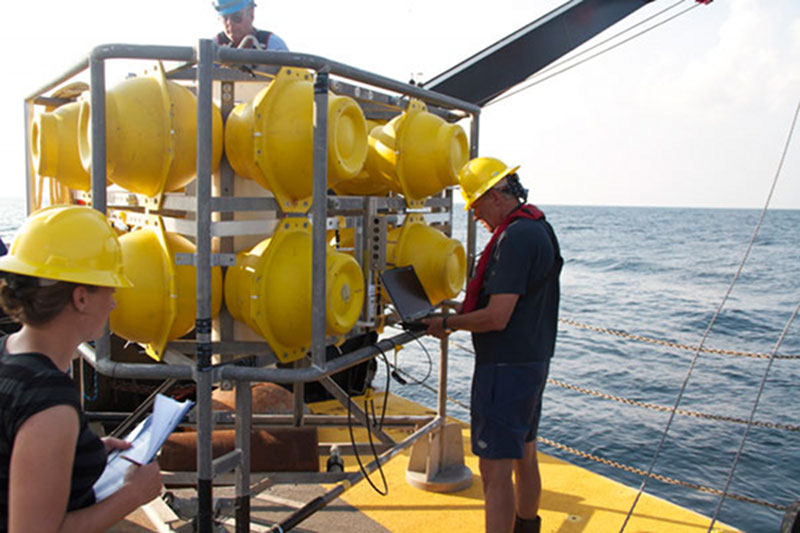
By Dr. Gerard Duineveld - Royal Netherlands Institute for Sea Research (NIOZ), The Netherlands
August 20, 2012

Gerard Duineveld doing some last minute programming on his lander, BOBO, just prior to launch. Dr. Furu Mienis pictured on left, Stephen Wallace, Able Seaman, helps with the rigging. Image courtesy of E. Hannerman, Deepwater Canyons 2012 Expedition, NOAA-OER/BOEM. Download image (jpg, 98 KB).
Submarine canyons have been formed and shaped in geological times when the sea level was much lower and sediment loaded streams cut through the seabed. But also in recent times canyons can act as important pathways for transport of particles from continental shelves to deeper waters and the deep-sea. These particles not only comprise sediment, pollutants but also nutritious organic material which forms a food source for the animals in deeper water. Flows of particles through canyons are not constant over time but occur in events triggered by hydrodynamics and weather conditions. Therefore, to obtain information on the importance of a particular canyon regarding its role in transport requires continuous observations over a long time period of years and preferably more.
For this purpose, biologists and geologists at the Netherlands Institute for Sea Research (NIOZ) have built benthic landers holding different types of sensors which have been deployed in various large canyons on the European continental margin. These deployments showed that the finest sediment and organic particles in one canyon may end up in some depot center while in another they become spread over the abyssal fan in the deep-sea. Such differences have large consequences for the types and distribution of animal species within the canyon and on the abyssal fan. Fresh algal particles proved to be an important parameter explaining patterns in the fauna community living in and on top of the sediment in the European canyons we studied.
During this cruise-leg we will deploy two NIOZ-built landers one of which will be placed near the Norfolk canyon head at 600 m and the other in the deeper part at 1300m water depth. If all goes well, landers will stay down for one year. Both landers are similarly equipped with a sediment trap, turbidity meter, fluorometer and current meter all contributing to measuring particle transport near the canyon floor. In cooperation with our other partners in this project additional landers and moorings will be deployed in Baltimore Canyon. The combination of turbidity and fluorescence measurements will show us if and when particulate transport includes any fresh nutritious algal material. Once we get the landers back, we will analyze the samples collected in the sediment traps for fresh algal constituents such as pigments. Sea floor samples collected via NIOZ box-corer will enable the analyses of sediment characteristics and benthic community structure by project partners from USGS and Bangor University. In combination with lander data from the different locations within the canyons this will provide a thorough canyon picture of the ecosystem and the way this is sustained.